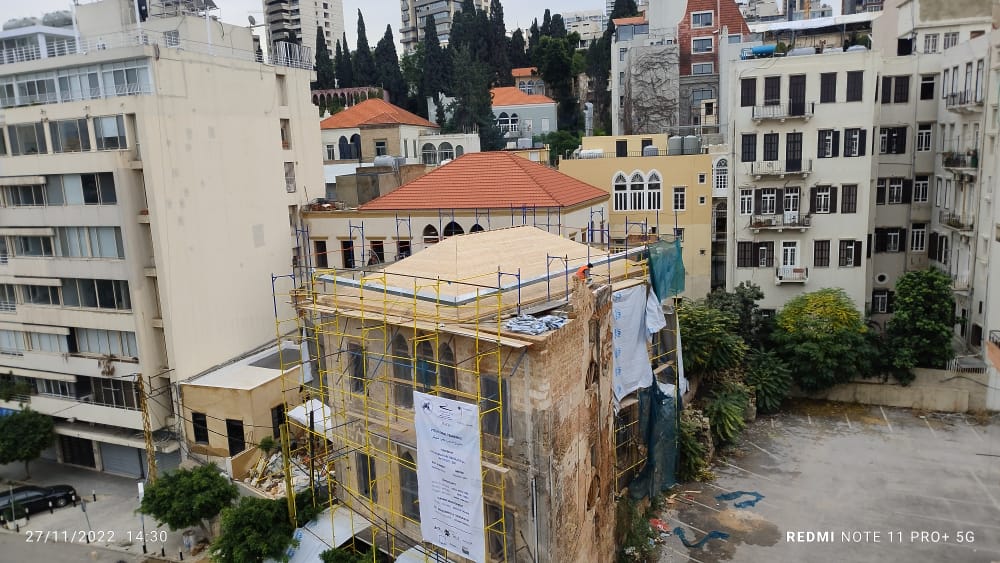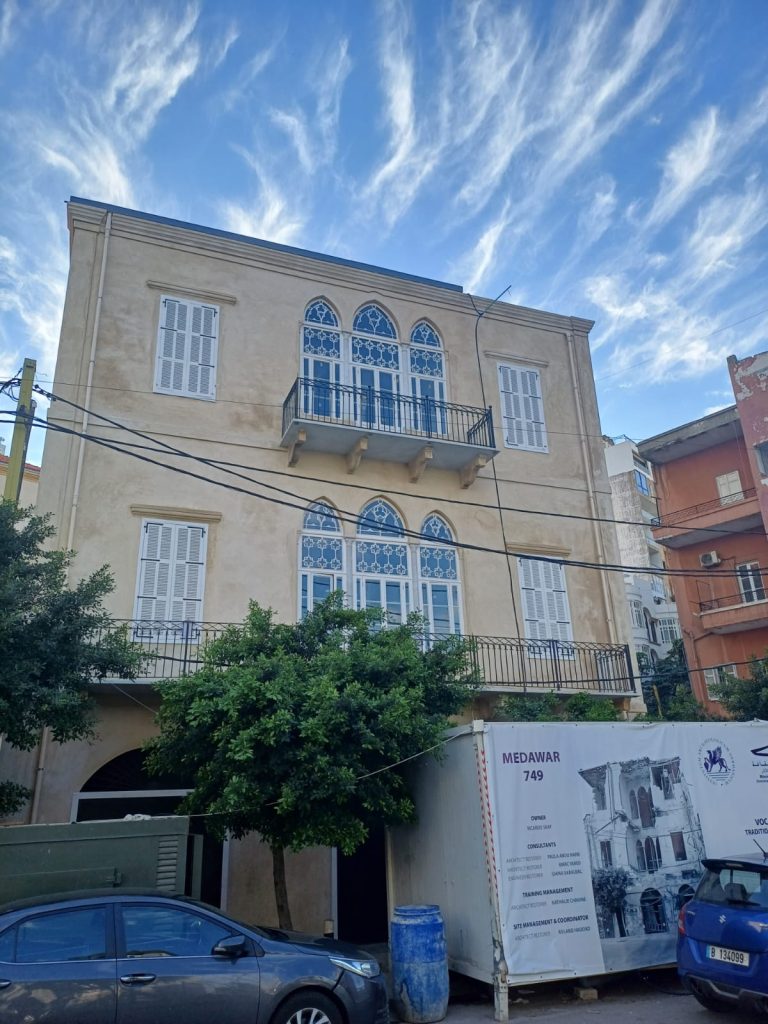ExecutiveMagazine - 8/14/2025 3:29:52 PM - GMT (+2 )
Five years have passed since the devastating blast at the Beirut Port and many of the areas of Mar Mikhael and Gemmayze appear to have been restored, as evidenced by summer scenes of residents, expats and tourists exploring and sipping cocktails in new cafes, pubs and restaurants. Yet a walk through these same streets confirms the blast’s lasting impact. Some heritage buildings are still under construction, with scaffolding in front of them, while others are empty, quiet, and untouched.
Beyond the physical repairs and the reopened businesses, there are other questions about what was lost, what was saved, and what has changed. Over the past five years, the neighborhoods hit hardest by the blast have undergone much of the same frenetic transformations that mark the rest of a city undergoing economic crisis and experiencing both periods of growth and periods of turmoil in fits and starts. Today, those working to restore and preserve heritage sites face challenges of waning economic commitments and shifts in both governance and demographic gentrification.
When the blast hit
At 6:07 PM on August 4, 2020, a massive explosion, now considered one of the largest and most devastating in modern history—rocked the city of Beirut triggered by tons of unsafely stored ammonium nitrate in Beirut port. The pressure and heat wave from the blast killed 218 people, injured more than 6,500, and left over 300,000 without homes. Nearby residential and commercial areas witnessed severe damage.
Physical destruction spread in areas near and far beyond the port. According to a September 2020 Beirut Explosion Impact Assessment by Strategy&, the explosion caused approximately 3.12 billion U.S. dollars of damage in housing, healthcare, education, businesses, and culture. The cultural and historic sector alone accounted for 286 million U.S. dollars, across 60 city districts, representing how much of Beirut’s identity was lost.
In neighborhoods like Gemmayze, Mar Mikhael, Achrafieh, and Karantina, modern-heritage homes from the period between 1920s to 1970s, suffered from shattered windows and door damage. Older traditional architecture buildings, from Ottoman-era to French mandate (1860s-1920s), were more severely damaged. Many of these buildings lost their signature Pirani wood roofs, signature stairs, and stained glass, elements which make these buildings irreplaceable to the city’s heritage and architectural identity. “The most painful part of the damage was to our traditional homes; we lost rare materials that we only find in older homes. This kind of detailed craftsmanship is difficult to recapture,” says architect and co-founder of Beirut Heritage Initiative, Joy Kanaan. The Beirut Heritage Initiative is an independent collective dedicated to restoring Beirut’s built and cultural heritage damaged by the blast.
A rush of rescuers
Within 48 hours after the blast, 40 restorers and engineers-initiated Beirut Built Heritage Rescue to support the Lebanon Directorate of Antiquities to assess the damage. Soon afterwards, 200 architectural students, graduates and teachers joined the initiative as volunteers. Together, 1,600 heritage buildings were assessed and categorized based on risk: those at high risk of collapse requiring urgent and early intervention, those with significant damage but no immediate danger of collapsing, and buildings listed in ‘green’ or ‘blue’ zones with only minor damage. “One hundred heritage buildings were in a state of extreme danger; at high risk of collapsing entirely, these buildings were very close to the port… We acted and consolidated these most vulnerable buildings before the winter,” explains Nathalie Al Chabab, an architect and cultural heritage expert.
Since day one, countless volunteers and civil society groups stepped in and supported the affected areas by clearing streets and removing rubble, helping with shattered glass, distributing food and water, offering shelter, and helping to repair damaged homes and businesses. This was believed to have drawn international and donor attention. “Once they saw us working … funds came,” Al Chabab recalls, referring to support from donors including the European Union, Canada, Qatar, World Bank, UN agencies, UNESCO, ALIPH foundation, the German Archaeological Institute, and various NGOs. Kanaan praises the effort of the extraordinary people that worked together to rebuild the neighborhoods “by the people and for the people.”
Thanks to this mass collective effort, none of the 100 buildings categorized as high risk collapsed. “What happened was a miracle” Al Chabab says. “All countries and construction companies now take the Beirut blast as a case study in heritage reconstruction, as nothing similar had ever happened.” Nevertheless, damage is still visible in the nearby neighborhoods. Rehabilitation efforts are still ongoing by UN-Habitat and the World Bank and are expected to soon be completed.
In other cases, some of these buildings have been abandoned for years or even decades, with multiple inheritors unable to agree on what to do with the property. These houses are only structurally consolidated; temporarily supported to avoid collapse but not rehabilitated. Al Chabab warns that such support can last for two to five years, but after that, intervention is critical. Kanaan says that some of these buildings still are in need of repair and others are on the market to be sold. She adds that right now, the biggest threat to modern and traditional heritage is that many of these buildings sit on large blocks and have gardens around them, which raise their real estate market value. On the other hand, she notes that some of the rehabilitated buildings have benefited from the post-blast restoration efforts. Before the explosion, many of these heritage homes had been neglected in cases where owners could not afford maintenance amid Lebanon’s economic crisis and the fluctuation of the Lebanese lira. Although the blast was devastating, it brought attention and funding that allowed some neglected buildings to receive needed repairs, and regain civic, state, and international attention.
The Airbnb effect
As buildings were enhanced and brought back to life, short-term rental markets such as Airbnb accelerated. Restored homes and buildings become prime assets and attractive not only for their architectural charm but also for their profitability. Airbnb listings began replacing long-term residential rentals at higher rates. “We know houses that were restored and had tenants but are now listed on Airbnb,” says Al Chabab, citing cases of landlords who took advantage of the new opportunity provided post-rehabilitation. In this climate of increased gentrification brought on by the short-term rental market, families, many of whom had lived in these heritage homes for years, found themselves unable to afford to live in their own neighborhoods.
Georges Shaaer, a shop manager who has worked in the same Mar Mikhael store since 1987, reflects on the area’s transformation. “Before 2020, this was a commercial and residential area; there were shops like mine, AC repair, auto parts. For three to four years after the blast, the area was dead. Now it’s all pubs. Maybe just me and two other shops remained in this street after the blast.” He adds: “Many didn’t come back. Renters left. These houses were turned into Airbnb; there are a lot of them in this area today.” As of mid‑2024, data from AirDNA, a platform that tracks global Airbnb performance, shows more than 2,200 listings in Beirut, many in traditional residential areas like Mar Mikhael. Following the blast and the economic collapse, more landlords saw Airbnb as an opportunity to earn income in U.S. dollar during the currency devaluation.
This trend, which did not begin in the aftermath of the blast but was arguably accelerated by the explosion—reflects more than just a shift in residents; it changed how the neighborhood feels and works. Gemmayze and Mar Mikhael were once known for having close communities, where neighbors knew each other, and local craftspeople ran small family businesses. Today, many of those families and small businesses are gone. In their place there are vacation renters and tourists, giving the area a more transient and less rooted feeling. Even so, some argue that Airbnb and similar models injected much-needed life and revenue into a paralyzed economy, especially during Lebanon’s economic, financial, and social collapse. But the lack of rental regulation, coupled with limited affordable housing alternatives, has made the situation hard for many.
How much recovery is real?
Internationally, recovery is often measured in terms of aid delivered and physical reconstruction projects. But real recovery must go beyond infrastructure and include restoration of homes, streets, and cultural landmarks that carry identity, collective memory, and meaning. Lebanon’s heritage architecture is a nation identity; its loss could deepen the national crisis.
After the blast, Law 194 was enacted in October 2020, which ceased the sale or modification of heritage buildings in blast-affected areas without approval from the Ministry of Culture. This measure aimed to prevent sales and protect Beirut’s architectural identity from uncertain real estate transactions and market-driven redevelopment. But unfortunately, the law expired in October 2022, and no similar law nor protections have been enforced since.
Kanaan warns that without clear laws or financial compensation and help; many owners are left with impossible choices. Maintaining a heritage structure is expensive, especially in a country
facing high inflation and ongoing multi-sectoral crises. “Many would rather sell or build high-rises to earn better income than leave an old house on a valuable plot” she says. The reason behind such decisions is often driven more by survival than greed in an environment where maintaining these buildings has become nearly impossible without support.
Even buildings officially classified as heritage by the Directorate General of Antiquities are at risk and often a burden for their owners. These owners can’t demolish or renovate them freely, yet they receive no technical or financial help to restore them. “They’re stuck,” Kanaan adds. “They can’t fix them, they can’t sell them, and they’re not supported by any governmental program.” She stresses the need for creative solutions. Cultural centers, museums, or NGOs could adopt these homes, use them, maintain them, and compensate the owners. Otherwise, the city risks losing more than just buildings, it risks losing pieces of its identity and soul.
But the challenges run deeper than just laws or funding gaps. Lebanon’s political and economic instability make it hard for anyone, either local or international, to invest and commit to long-term cultural projects. “We understand the situation is difficult,” Kanaan says, “but unless institutions like the Honor Frost Foundation [a nonprofit organization that promotes the research and preservation of maritime archaeology, with a focus on the Eastern Mediterranean] or others adopt these buildings as offices, galleries, or cultural spaces, we will keep losing them.”
Trauma beyond the rubble
For many, the emotional scars of the blast remain open. “Psychologically? Of course we did not recover,” Al Chabab says; “the trauma is not over.” Mar Mikhael shop owner Shaaer agrees. “The country stands on a thin line. Another explosion, another wave of war, we just keep going and working.”
“The damage is not just physical; it is emotional and psychological. It was an absolutely devastating explosion,” says Kanaan. She emphasizes that true recovery requires more than fixing and repairing buildings, arguing that the area will recover completely when there is security, economic stability, and when heritage buildings are not only protected, but alive and part of the urban environment.
read more








